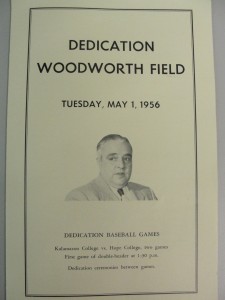
Rob Dunn ’97 is at it again; it being another citizen-science project (or two). And it (or they) are the subject of a fun and wonderful piece by Nicola Twilley, “What’s Lurking in Your Showerhead,” that appears in the December 8 issue of the New Yorker magazine.
Rob is an evolutionary biologist and professor at North Carolina State University. Twilley is one of 500 participants in his lab’s Showerhead Microbiome Project. Those volunteers (in Europe and the United States) swab the gunk in their showerheads and send the samples Rob’s lab. Twilley found it a tad gross, but Rob wonders if it’s a good thing–those microorganisms in our showerheads. Turns out our bodies are full of other bodies–we depend on them. In fact, those other bodies’ cells (in or on us!) may outnumber our own, making me more other than myself. Wow! Whether or not what’s in our showerheads is good (or not so good) for us remains to be tested. First we have to see what’s in there in order to ask the right questions. Rob’s full of those; he’s a K grad. He’s also interested in the effect (for good or ill) on our “showerdough” of different water treatment processes.
Please forgive that “showerdough” malapropism; there’s a reason for it. Rob’s second current citizen-science project is all about the affect of microorganisms on sourdough and, ultimately on the taste of sourdough bread–across space and time. Some really interesting things may be going on there! Read Twilley’s article to find out. Citizen-science is nothing new to the Dunn lab. He’s done projects on belly button lint, human facial mites, insects in the kitchen, and household dust. Robs the author of three popular science books and was featured (“The Ant on Aldebaran”) in the Fall 2015 LuxEsto.


 In May of 2013 alumnus David France ’81 returned to Kalamazoo College’s campus to present his Oscar-nominated documentary “How to Survive a Plague.” David has recently written and published a book of the same title, How to Survive a Plague: The Inside Story of How Citizens and Science Tamed AIDS. On November 21, the New York Times published a rave
In May of 2013 alumnus David France ’81 returned to Kalamazoo College’s campus to present his Oscar-nominated documentary “How to Survive a Plague.” David has recently written and published a book of the same title, How to Survive a Plague: The Inside Story of How Citizens and Science Tamed AIDS. On November 21, the New York Times published a rave  Kalamazoo College’s
Kalamazoo College’s  Christina C. Bodurow ’79, senior director of external sourcing in the medicines development unit at Eli Lilly & Co. (Indianapolis), has been elected the District II Director for the American Chemical Society for 2017-2019. District II includes counties in Michigan, Indiana, Ohio, Pennsylvania, Kentucky, Tennessee, West Virginia, Virginia and North Carolina. At K Christina majored in chemistry. She served in student government, participated on the Hornet tennis and swimming teams, and played in the Jazz Band. She studied abroad in Erlangen, Germany. Christina earned her Ph.D. in organic/organometallic chemistry at Princeton University (1984). After graduate school she began her career at Eli Lilly in the chemical process research division. She led the early phase development of a number of neuroscience medicines, including the global submissions of nine new chemical entities. Kalamazoo College congratulates Christina on her ACS election.
Christina C. Bodurow ’79, senior director of external sourcing in the medicines development unit at Eli Lilly & Co. (Indianapolis), has been elected the District II Director for the American Chemical Society for 2017-2019. District II includes counties in Michigan, Indiana, Ohio, Pennsylvania, Kentucky, Tennessee, West Virginia, Virginia and North Carolina. At K Christina majored in chemistry. She served in student government, participated on the Hornet tennis and swimming teams, and played in the Jazz Band. She studied abroad in Erlangen, Germany. Christina earned her Ph.D. in organic/organometallic chemistry at Princeton University (1984). After graduate school she began her career at Eli Lilly in the chemical process research division. She led the early phase development of a number of neuroscience medicines, including the global submissions of nine new chemical entities. Kalamazoo College congratulates Christina on her ACS election. Kalamazoo College announced today that Writer in Residence and Assistant Professor of English Diane Seuss ’78 will receive the 2017 Florence J. Lucasse Fellowship for Excellence in Scholarship. It is the highest award bestowed by the Kalamazoo College faculty, and it honors the recipient’s contributions in creative work, research and publication. Seuss is the 28th person in the College’s history to receive the award.
Kalamazoo College announced today that Writer in Residence and Assistant Professor of English Diane Seuss ’78 will receive the 2017 Florence J. Lucasse Fellowship for Excellence in Scholarship. It is the highest award bestowed by the Kalamazoo College faculty, and it honors the recipient’s contributions in creative work, research and publication. Seuss is the 28th person in the College’s history to receive the award.



